NVIDIA's GeForce GTX 580: The SLI Update
by Ryan Smith on November 10, 2010 10:00 AM ESTPicking up immediately from where we left off yesterday with our review of NVIDIA’s new GeForce GTX 580, we have a second GTX 580 in house courtesy of Asus, who sent over their ENGTX580. With our second GTX 580 in hand we’re taking a look at GTX 580 SLI performance and more; we’ll also be taking a look at voltage/power consumption relationship on the GTX 580, and clock-normalized benchmarking to see just how much of GTX 580’s improved performance is due to architecture and additional SMs, and how much is due to the clockspeed advantage.
| Asus ENGTX580 | GTX 580 | GTX 480 | GTX 460 1GB | |
| Stream Processors | 512 | 512 | 480 | 336 |
| Texture Address / Filtering | 64/64 | 64/64 | 60/60 | 56/56 |
| ROPs | 48 | 48 | 48 | 32 |
| Core Clock | 782MHz | 772MHz | 700MHz | 675MHz |
| Shader Clock | 1544MHz | 1544MHz | 1401MHz | 1350MHz |
| Memory Clock | 1002MHz (4008MHz data rate) GDDR5 | 1002MHz (4008MHz data rate) GDDR5 | 924MHz (3696MHz data rate) GDDR5 | 900Mhz (3.6GHz data rate) GDDR5 |
| Memory Bus Width | 384-bit | 384-bit | 384-bit | 256-bit |
| Frame Buffer | 1.5GB | 1.5GB | 1.5GB | 1GB |
| FP64 | 1/8 FP32 | 1/8 FP32 | 1/8 FP32 | 1/12 FP32 |
| Transistor Count | 3B | 3B | 3B | 1.95B |
| Manufacturing Process | TSMC 40nm | TSMC 40nm | TSMC 40nm | TSMC 40nm |
| Price Point | ~$510 | $499 | ~$420 | ~$190 |
As you may recall from our launch article yesterday, NVIDIA would only make a second GTX 580 available to us for SLI testing if we also accepted and reviewed a high-end gaming system, an offer which we declined. As a result we were unable to look at GTX 580 SLI performance right away. However Asus quickly came to our aid and sent us one of their first GTX 580s, giving us a second card to work with both for SLI testing and as a second data point. Since yesterday afternoon we’ve been busy at work seeing what a pair of NVIDIA’s latest and greatest are capable of doing.
It shouldn’t come as any surprise that as a launch-day card, the ENGTX580 is an almost identical carbon-copy of the GTX 580 reference design. Asus is using the reference PCB and cooler, and are differentiating the card through a very token 10MHz factory overclock and the possibility of a much greater overclock through voltage adjustment using their SmartDoctor utility (which we do not have in hand at this time). At this point the factory overclock has us scratching our heads however, as this is the second Asus card we’ve received with such an overclock. We’re not ones to look a gift horse in the mouth when it comes to a free performance boost, but 10MHz (1.2%) core overclock? It’s the very definition of a token overclock – it’s not enough of an overclock to actually make a difference in performance. We’re still trying to get to the bottom of this one…
About Last Night
Prior to the actual launch of the GTX 580, we were concerned about what the availability would be like. With NVIDIA engaging in such a quick development cycle for GF110 and being unwilling to discuss launch quantities, we didn’t think they could do it. We’re glad to report that we were wrong, and the GTX 580 has been in steady supply since the launch yesterday morning. Kudos to NVIDIA for proving us wrong here and hitting a hard launch – it’s the kind of action that helps to make up for the drawn out launch of the GTX 480 and GTX 470.
Actually getting a GTX 580 is turning out to be a curious affair however. When we first saw Newegg post their GTX 580s for sale our jaw dropped as they were all $50-$80 over NVIDIA’s MSRP; the GTX 580 is already an expensive card and selling it over MSRP isn’t doing NVIDIA any favors. However after checking out MWave, Tiger Direct, the EVGA Store, and others, we saw at least 1 card at MSRP at each store. Were NVIDIA and their partners price gouging, or was it something else? The truth is often in the middle.
At this point Newegg is the 800lb gorilla of computer parts; they have the largest volume and as far as we can figure they get the bulk of the launch cards allocated to the United States. So what they’re doing is usually a good barometer of what pricing and availability is going to be like – except for this week. As it turns out Newegg is running a 10% sale on all video cards via a well-known promo code; and as best as we can tell rather than not including the GTX 580 in their sale, they simply hiked up the price on all of their GTX 580 cards so that prices were at or around MSRP after the promo code was applied. The end result being that the cards look like they’re going well over MSRP when they’re not. Judging from pricing at Newegg and elsewhere it looks like there is some slight gouging going on (we can only turn up a couple of cards that are actually at $499 instead of $509/$519), but ultimately GTX 580 prices aren’t astronomical like they appeared at first glance. After this stunt, this will probably go on the record as being one of the weirder launches.
Asus’s ENGTX580: A Second Data Point
With a second GTX 580 in hand we have a second data point to look at with respect to the GTX 580’s physical attributes. As we’ve noted time and time again, with the GeForce 400 (and now, 500) series, NVIDIA has moved to having a range of VIDs for each product instead of only a single VID for every card. The result is that much like CPUs the power consumption and resulting cooling/noise properties of a product can vary from card to card.
Our reference GTX 580 shipped with a load voltage of 1.037v, notably higher than the sub-1v load voltages of the GTX 480 and a solid example of how NVIDIA has been able to reduce leakage on their GPUs. By luck our Asus GTX 580 comes with a different voltage, 1.000v, giving us some idea of what the VID range is going to be for the GTX 580 and what a card with a “good” GPU might be like.
| GeForce GTX 480/580 Voltages | ||||
| Ref 480 Load | Ref 580 Load | Asus 580 Load | ||
| 0.959v | 1.037v | 1.000v | ||
Not surprisingly, with a lower load voltage our Asus card consumes less power in all of our tests. We’ll just jump right in to the charts here and dissect things.
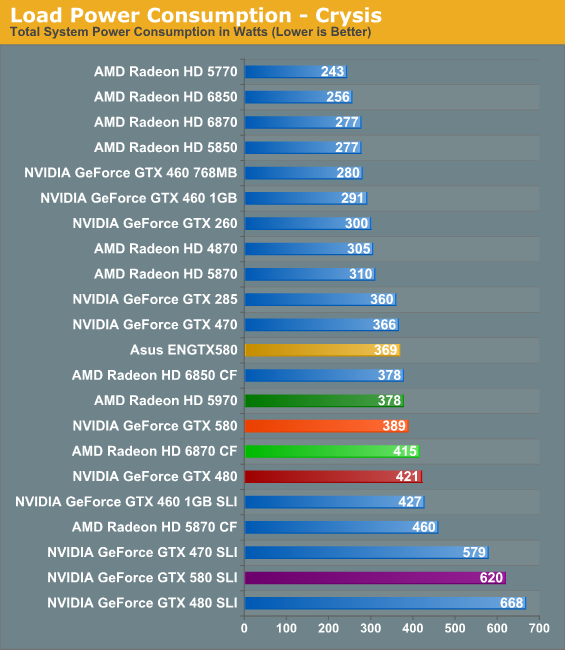
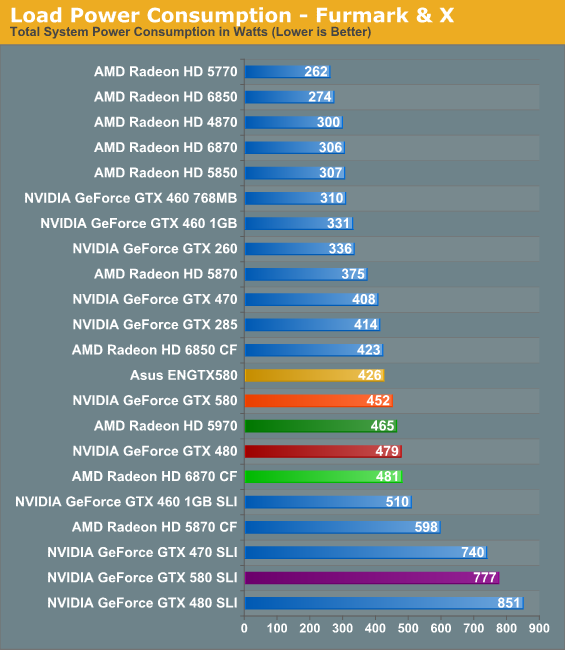
Under Cyrsis system power consumption is 20W lower, putting this GTX 580 under the Radeon HD 5970 instead of over, but also within 10W of the 6850CF, the GTX 470 (with its fused off SMs), and even the GTX 285. Going by power consumption this card is only slightly worse than the GTX 285, a far cry from the GTX 480 and the 421W system power consumption we see.
The situation is much the same with Program X, where power consumption has dropped 26W to 426W. Here it’s a not quite as close to the GTX 470, but it’s still only a dozen watts or less off of the GTX 285 and 6850CF.
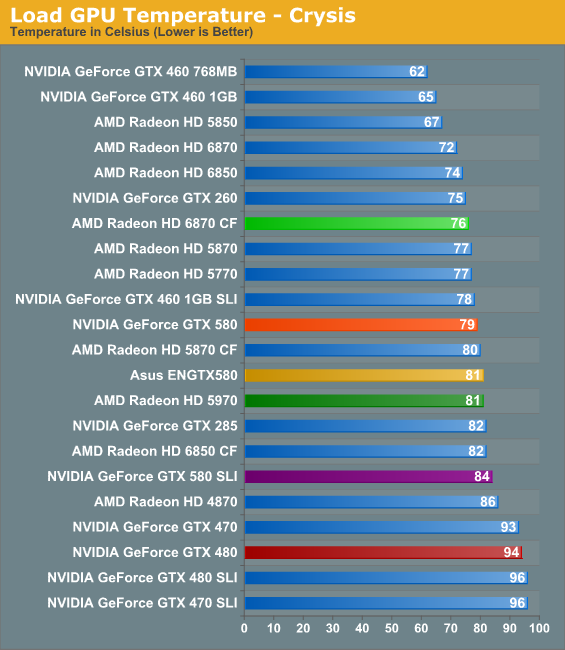

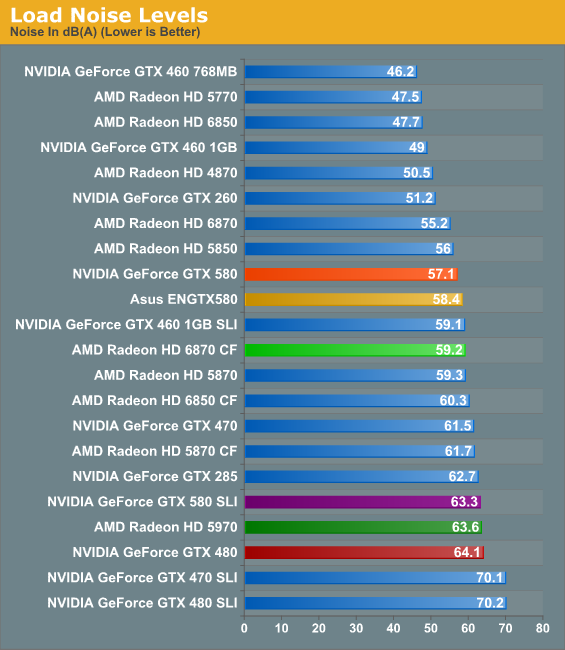
However it turns out the effect on temperature & noise isn’t as great as we’d assume. These two aspects are of course dependent on each other, as temperatures drive fan speeds and vice versa. For whatever reason our Asus GTX 580 gets slightly warmer and slightly louder than our reference GTX 580, even though we’ve already determined that power consumption – and hence heat dissipation – are lower. Some of this may come down to BIOS programming by Asus, but at the moment we don’t really have a great explanation for why power consumption can drop but heat/temperatures can slightly rise. At the moment we’re entertaining the idea that the difference may be in assembly, and that the reference GTX 580 has a different thermal paste application than the Asus card.
In any case from these two data points we can clearly determine that power consumption can differ from our reference card, however whether temperatures and noise can differ are still in question. Ultimately we’d like to find out the full VID range of the GTX 580, if only to get an idea of how our cards compare to the complete spectrum of possibilities.


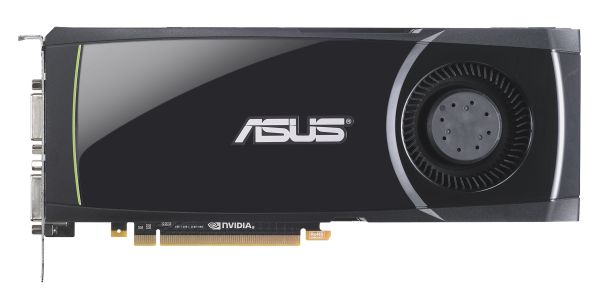









82 Comments
View All Comments
maverick7614 - Wednesday, November 10, 2010 - link
Hi guys,Thanks for the great review of the GTX580 from yesterday!
I know this is a bit off topic regarding GTX but as someone that just received as a gift a GTX480 recently, and has no space in the case to use a 3 slot air cooling solution, I was wondering if it would be possible to fit the new GTX580 cooling solution on a GTX480.
If this would be possible it would be great if you guys could retest the temperatures, noise and power draw for such a modded GTX480.
Regards,
Alex
slickr - Wednesday, November 10, 2010 - link
I see no reason why you would want to keep CIV5 in the benches, since its obviously not reliable to test graphic card speeds.I would like you to add another strategy game in its place, something like Total war series, you know with large scale combat and all that good stuff.
And why isn't there no Starcraft 2 benchmark there, its basically one of two PC only titles and yet you don't include it?
smookyolo - Wednesday, November 10, 2010 - link
I say they benchmark Age of Empires.The first one.
8D
Exodite - Wednesday, November 10, 2010 - link
While it's clear from this review, as well as others, that the GTX 580 is a significant improvement over the GTX 480 in power usage, temps and noise I realized that what I've actually taken away from reading it is how totally awesome the Radeon 6870 is. In CrossFireX especially.I reckon that's not quite what Nvidia had in mind but meh, it seems the absolute extreme-end cards still aren't a winning proposition.
silverblue - Wednesday, November 10, 2010 - link
Aside of the odd issue with minimum frame rates, Barts is a notable improvement over Cypress for Crossfire. If I was to paraphrase a quote taken from the 460 launch, this would be Evergreen done "right", at least in terms of multiple graphics card setups - better scaling and better power usage essentially means less waste, and it's not as if Evergreen was hungry to start with. Just a shame that AMD has effectively limited Barts to two cards at once.As for the 580, very well done, however I think we're going to have to wait for another redesign before power usage is properly tackled.
spiked_mistborn - Wednesday, November 10, 2010 - link
It would be nice if you could include 5770 CF scores in the future. I have a Sapphire Vapor-x running at 960 / 1350 and it's very quiet and performs ok, and I could get another one for about $140 on Newegg. The 5770 has similar or faster tesselation performance to that of 5870 (due to faster clock speed) and in CF has similar shading / texturing abilities. It would be nice to see how 2 of these at stock speeds compare to the other cards. Overall this is a great article as always!Folterknecht - Wednesday, November 10, 2010 - link
2x 5770 ~ 1x 5870Neomis - Wednesday, November 10, 2010 - link
What are the pc specs on this test system? it would be nice to know what processor/Clock limited some of these tests...shaggart5446 - Wednesday, November 10, 2010 - link
look how quick he do an sli and the 580 just release yesterday and when the 6870 and 6850 was release there wasnt any xfire the next day but he could also do an over clock 460 sometimes i wonder why amd even send u guys card to reviewhaukionkannel - Wednesday, November 10, 2010 - link
Well, most simple explanation between these different heat result is that the review part was cherry picked (like they normally are, so that you can get better overclockin results etc.) and the Asus one is normal version, that you can normally expect to get.When the production run gets better, I think that we will see more chips that are more like the early cherry picked one...